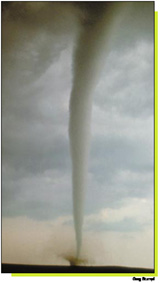|
Natural Hazards and Disasters
Since the beginning of time, Floods, earthquakes, hurricanes, tornadoes, volcanoes, tsunamis and avalanches have devastated
the earth.
Natural Hazards are the main cause of worry in people. It's not something that can potentially harm you,
but it can if it becomes a natural disaster. A natural hazard becomes a natural disaster when it becomes
activated or reacts in a way that can harm you. Natural Disasters are the number one cause of deaths and injurys around the
world.
Comparing & Analyzing Natural Disasters
Examples of Grid Systems:
Frequency: Tells how often an event is going to happen.
Duration: The length of time an event lasts.
Extent: How far the even will reach, and/or how much its going to spread.
Speed of Onset: Lets people know when the disaster is going to happen.
Spatial Dispersion: Tells you what area the disaster is going to affect.
Temporal Spacing: This tells you how hazards or disasters occur in time. Like, if there's going to be a certain pattern.
Classifying Natural Disasters
Recent studies have showed that the most common way of comparing natural disasters is to measure the impact they have on a
place. I.e. the damage, the number of deaths, and the number of injuries the disaster causes. There are three main classifications
of natural hazards. Atmospheric, biological, and geological, but you can also classify them by the impact they have
on us as human beings, by the regions where they occur, and by how many times they occur.
Atmospheric Hazards
There are four types of atmospheric hazards.
Tropical Cyclones - These develop because of the high temperatures and large amounts of water vapor in the air. They
are called by two names. Hurricanes and/or Typhoons.
Tornadoes - They originate over land, and always occur in the middle latitudes and a combination of thunderstorms.
Tornadoes may be small, but they can be fierce. They are also triggered when warm, humid air is forced to rise over cooler
and drier air.
Floods and Flooding - There are a number of reason why floods occur, but the main reason is too much
rain. When a lot of rain falls, it causes rivers to over flow and have excess water and no run off. This causing the lowland
areas to be the first to get it.
Drought - Too little water over a long period of time can cause land to dry up, and make farm living
horrible. Extended droughts are the one of the major causes of deaths, and illnesses.
|
 |
|
|
|
 |
|
Straight From The Books
Carbon Cycle - The movement of carbon from the atmosphere into plants, animals, the soil, and back into the
atmosphere again.
Nitrogen Cycle - The movement of nitrogen from the atmosphere into plants, animals, the soil, and back into
the atmosphere again.
Global Warming - The theory that the Earth's average temprature has risen as a result of increased carbon dioxide
into the atmosphere from fossil fuel burning and human activity.
Water Cycle - The movement of water from the atmosphere in the form of condensation and precipitation and back
into the atmosphere though transpiration and evaporation.
Denitrification - The process of nitrates breaking down releasing nitrogen gas.
Transpiration - The process by which water vapour is released from plants into the atmosphere.
Gaia Hyphothesis - The theory proposed by James Lovelock that the earth is a self-regulating, self-sustaining
system and can be viewed as a single, living organism.
The Role of Human Beings in Natural Disasters
The Global Connections textbook states that "natural disatsters are disasters only when human beings become involved in them."
Although we try to prevent natural disasters from happening, we contribute to them more than we know. For example, when we
litter we contribute to pollution which causes sickness, and thins the atmosphere. One roll us as human beings could take
part in, is disaster warnings. Take them seriously, because it will cause less deaths and injuries.

|
 |
|
|
|

